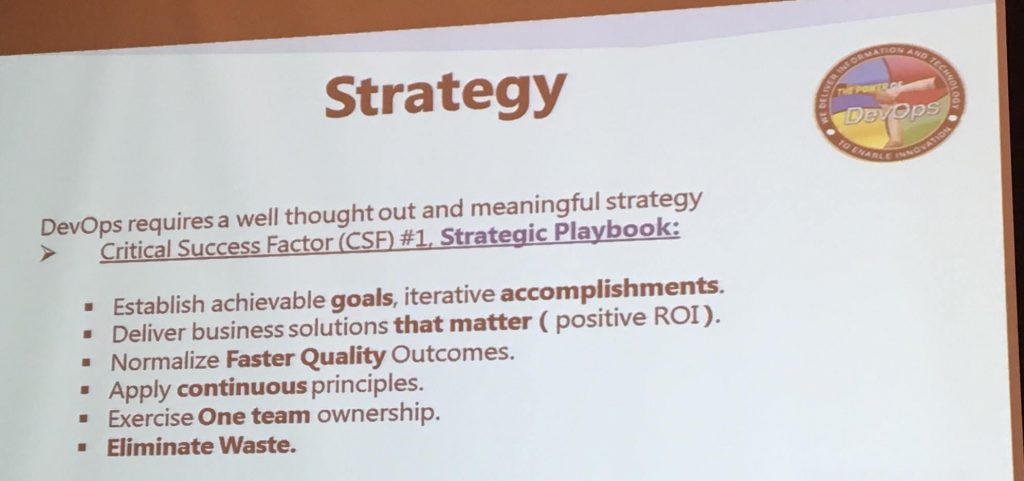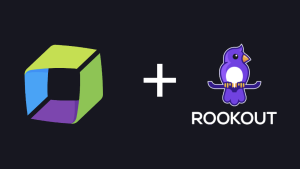In June I was invited to present my view on DevOps at the ATARC – Federal DevOps Summit in Washington, DC. Little did I know that my assumption of government agencies lagging in the adoption of the latest technologies and practices was WRONG. And this was proven so many times throughout the day as representatives from government agencies took the stage and explained how their teams are fully embracing Cloud, Micro-Services, Continous Delivery and DevOps! Or as they call it: #DevOpsFeds!

My key takeaways
Throughout the morning keynotes I had a lot of “A-HA!” moments. I was, for instance, not aware that government agencies would consider public Cloud or that there are some agencies that deploy changes of their micro-service architectures several times a day. I also learned that #DevOpsFeds – when done right – can be a great collaboration boost between the agencies and their contractors. The following is a picture I took from this panel discussion – which for me was the highlight of the day!

I took a few notes during the sessions and you might find them useful. Let me know if you have detailed questions – for some presentations I just took brief notes – but happy to share more details. What I assume you will see regardless, is that the time has come to not only learn from the public sector but also from the agencies!
Jim Tunnessen, Chief Digital Officer, Voice of America (@techBytesIO)
Jim, who used to be a CTO for one of the agencies, calls DevOps ”Common Sense IT“. I learned that they had not been doing conferences to level-up their teams. Realizing this, he put “Visit Public Tech Conferences” into everyone’s Performance Appraisals to make sure they were aspired to learn from others. The quote from one of his Enterprise Architects after coming back from one of these conferences is priceless: “It is as if I have lived in North Korea and finally I got to see the rest of the world!”

Jim draws parallels from the digital disruption in Media technology to the digital disruption in IT Technology. Right now in his current role at Voice of America, he and his team are leveling up the way they create media content for the different channels Here they are challenged by both disruptions: providing State-of-the-Art media channels and deliver them in a more agile, rapid way.
Jim also gave us an outlook on what his agency is working on to stay on-top of technology disruption:
- Live Streaming in Different Languages
- Drones for Filming
- 360 Cameras
- Augmented Reality
- This one I like a lot: Data-Driven Decision Making!
Key pieces of advice:
- Step 1 was to let Dev, Ops and Sec collaborate
- Step 2 is to coordinate and collaborate with the Business!
Sarah Fahden, Chief, Verification Program Portfolio, USCIS, DHS (@sarahfahden)
Sarah (also part of the panel discussion mentioned earlier) uses the “Strangler Approach” to migrate their monolithic apps gradually into AWS / Microservices / Docker environments. Her team uses a “Preview” mode in production to test new features internally in production. They then turn it live for everyone. Today they are deploying multiple times a day into public AWS.
Pipeline Facts
- Every Micro-Service Team has its own Pipeline with different speeds
- Everything is automated
- The CI/CD Pipeline is automated in all the stages, including security!
Dustin Laun, Senior Advisor, Technology & Innovation, FCC
Dustin believes that in today’s world, IT doesn’t need to be the bottleneck. Understand where the bottlenecks and risks are, and optimize them.
If you don’t sell the tool you should be coding. They have the 80/15/5 rule: 80% Platform, 15% Platform Code, 5% Custom Built. That means they are investing 80% into basic platform capabilities. Build 15% code on top of that platform and only do 5% custom coding outside that platform.
Mark Schwartz, Chief Information Officer, USCIS, DHS
I have seen Mark Schwartz present at different events in the past. At the DevOps Enterprise Summit (DOES) in 2014, he presented on “How DevOps can fix the Federal Government” (check out this YouTube recording). I went light on the notes as the message was aligned with what I heard at DOES. For more info on this one, check his existing recordings at the link here, or check out his book “A Seat at the Table”. Mark definitely stood out in his in his work with the government as he’s just been hired by the Amazon Web Services Team J!
Pamela I. Isom, Director, Application Engineering and Development (@pkison)
3 DevOps Transformation Success Categories: Strategy, Technology, Execution!

Technology:
- Choose technologies based on use case(s)
- Treat automation like software engineering -> Quality Code Coverage, Canary Pipeline (+ measurements)
- Make solid architectural decisions
Mike Hermus (DHS CTO | @MikeHermus)
Mike works for the Department of Homeland Security. I captured the following quotes which I think nail it when it comes to understanding why the DHS has to transform:
- “Getting good at IT is a matter of national security!”
- “We might not be disrupted by a competitor but by other adversaries”
- “Note the latest cyber-attacks – for us it is about how quickly we adapt to these new threats!”
Major Shifts in the Digital World
- Acceleration of Velocity!
- From Years –> Weeks; From Months –> Days; From Minutes –> Seconds
- Decomposition of Requirements:
- From Buildings –> Bricks; From a Trickle –> To a Torrent; From Centralized –> To Distributed (THE API ECONOMY!!)
- Refocusing of Work:
- From Projects –> To Products; From Deliverables –> To Outcomes; From Hierarchical à To Flat
Adoption of Attitude: SEE IMAGE

Ready to learn from the Government?
Learning from the government sector was something I had not looked deeply into prior to attending ATARC, the Federal DevOps Summit. From the view of living in the U.S. now, I can see that what is happening in IT in the U.S. government is probably like the Austrian government, where I am from originally. And, while government and agencies may not have the intense competitive drive to modernize and transform, they are challenged by many of the same demands:
- They need to become more agile and efficient in both delivery and operations
- They need to adapt and keep pace with rapid technology change
- They need to become and go-to and competitive employer for IT personnel and expertise
- They need to transform even faster than public companies because of new, and serious critical threats like cyber attacks
If you want to learn more about my thoughts on DevOps, and scaling DevOps for Cloud, and also what unique value Dynatrace has in managing IT complexity, like in the Government sector, take a look at my article in GovLoop “Delivering Better Digital Services with DevOps”, see this Tech Note “Scaling DevOps to Deliver Better Software Faster for Government Agencies”.





Looking for answers?
Start a new discussion or ask for help in our Q&A forum.
Go to forum